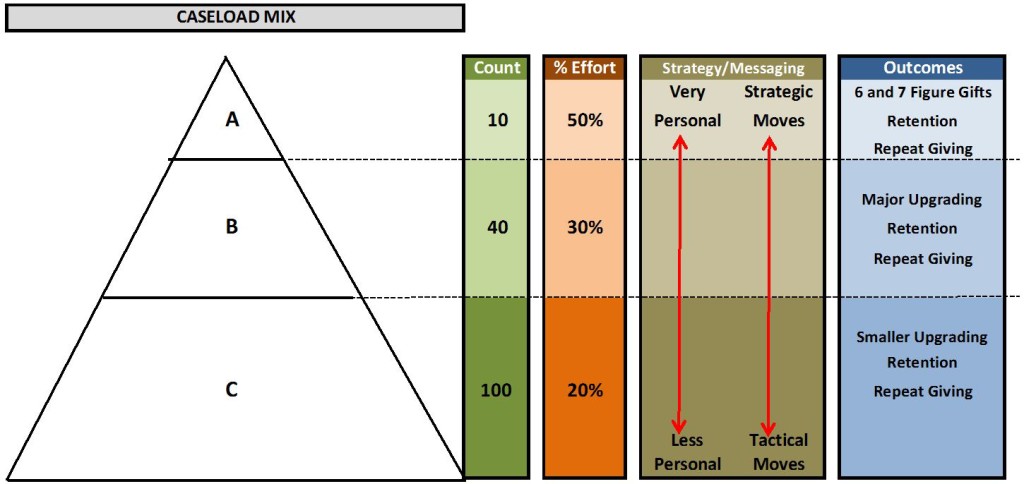2 min read
No Answer? Try 7 Times!
We have all had the experience. We try to contact donors and no answer. They will not answer the phone. They will not answer their email. They...

Things are not going well for you as an MGO. You feel as though you are not managing your donors properly or, in many ways, you could be managing them better. You are behind in revenue and it’s time to take a look at HOW you are doing things. Well, if this describes, even in a tiny way, what you are feeling or experiencing right now, then it’s time to get back to basics and look at caseload composition and management.
In fact, Jeff and I recommend you look at this at least once a quarter. Why? Because as time passes, you will most assuredly slide into a place of focusing on the wrong donors and not staying on point strategically. The law of entropy will have its effect. In other words, as time passes, things tend to decline.
This reality is why Jeff and I frequently give our opinion on the ideal composition of a caseload and how much time we believe you should spend on each type of donor. Here’s what we think.
First, as we have always said, your caseload should have no more than 150 qualified donors. Emphasis on the word qualified. These are donors who meet the organizational metric or criteria for major gifts and, through contact, have determined that they want to have a more personal relationship with you. Don’t just add donors to a caseload because they gave a large gift. You need to know that the donor desires or will be open to a different type of engagement.
Secondly, you have tiered these donors based on current giving and capacity. The higher givers with higher capacity are your A’s and you go down from there to your B’s and C’s. Note that we are saying there are very few A donors, maybe ten at most, then 40 or so B’s and 100 C’s. This is not a strict rule – I am just trying to communicate a principle.
On strategy and messaging you will note that the A donors get more personal attention and an application of more complex strategies and approaches, while B and C donors get less. Pretty basic, I know, but we continually find even seasoned MGOs who do not follow this rule. They either treat every donor in the same way or have their “favorites” they pay more attention to, regardless of the donor’s ability or intention of giving. This is a misuse of time and poor management.
If you have categorized them properly, the A donors will have the greatest potential for major giving. And that is where you should spend most of your time and effort while you keep looking in the B and C category for A type donors. It could be that you either mis-classified them or they have developed, through your cultivation, into A donors.
Where is all of this headed? Toward 6- and 7-figure gifts from A donors!
Now, I know that some folks reading this blog have either been rolling their eyes or tapping their fingers impatiently as they have been consuming this information. Jeff and I have heard it hundreds of times. “This is so basic. Any MGO worth his paycheck is doing this!” No he isn’t! And that’s the problem.
Just last week I sat with an MGO of a very large non-profit who has some very generous, high capacity donors on his caseload. And as we were reviewing the strategies and approaches this good MGO was using on his caseload, it violated everything I just said above.
So I stopped, again, and for the fifth time said, “Bill, (not his real name) we have talked about this before. In fact, we have talked about it many times. Why don’t you treat these 14 donors a little bit differently than the rest of them?”
“Well, I’ve been meaning to,” he said. And then there was a litany of excuses that, essentially, covered up a lack of discipline and focus, which was the core problem. And this MGO, out of all the other MGOs on the team, is behind on revenue for the year and struggling.
This area of being strategic, focused and disciplined in managing a caseload of donors is the number one reason MGOs fail at their jobs. It is not as much about moves management, creative new approaches, having something to present to donors, etc. It is about caseload management. And that is why Jeff and I feel so strongly about this point.
Take some time now to look at your caseload and make sure you are (a) categorizing your donors properly, and (b) managing them in a strategic, focused and disciplined way.
Richard
2 min read
We have all had the experience. We try to contact donors and no answer. They will not answer the phone. They will not answer their email. They...
You have likely been in the situation where a current or new donor reaches the $500+ cumulative level of giving, and either the MGO drops everything...

I just don’t know what it is, but lately I’ve been working with many MGOs who are really struggling with confidence. Either they’ve recently had a...